Dynamical Interpretation of Leibniz's Continuu
Continuum’un dinamik olan bu yorumu üçlü bir perspektife dayanmaktadır. İlkin Leibnizci Weltanschauung’un bütün standart gerçekliklerinin – (R gerçek), (P fenomenal), (I ideal)- detaylı olarak ayrımlaştırılması. İkinci olarak, Leibniz tarafından çok iyi bir biçimde formüle edilmiş olan süreklilik yasasının kapsamının bir analizi ve onun bu (RPI) yapısının üzerine yerleştirilmesi. Üçüncü olarak ise bu (RPI) continuum’unda dinamiğin ve gücün tam olarak yerinin belirlenmesi. Eğer bu üç perspektif (sınıflayıcı, kural koyucu, ve birleştirici) bir araya getirilirse monadların rolünün yeni bir kavrayışına yol açar; ve monadlar artık sadece Leibnizci felsefenin sağduyulu parçaları olarak değil (ideal uzay ve zamana karşı olarak), fakat hem bitişikliği hem de sürekliliği kendi içine katan dinamik bir continuum olarak ele alınacaktır. Ve böylesi bir yolla onlar, syncategorematic fenomenal sonsuzluğu hem etkisizleştirecek hem de muhafaza edecektir. Temel husus, gücün, monadların algılarına ve iştihalarına uygulanabilir olmasıdır, ve bununla biz, Zenon’un Dikotomi paradoksuna Leibnizci cevabın en kısasını vermiş oluyoruz: “Güç”. Fakat daha da önemli olan şey, böylesi dinamik bir yorumun, olgun Leibnizci felsefenin iyi şematik ve sistematik bir görünüşünü vermesidir. Ve görünüyor ki (beklenildiği gibi), Continuum Labirentinden çıkış yolu sadece geometrik ve fiziksel değil, fakat aynı zamanda metafizikseldir.
Leibniz'deki Continuum'un Dinamik Bir Yorumu
This dynamical interpretation of the continuum is based on a threefold perspective. First, detailed differentiation of all standard realms of Leibnizian Weltanschauung – (R real), (P phenomenal), (I ideal). Second, analysis of the scope of the Law of Continuity famously formulated by Leibniz and mapping it onto this (RPI) structure. Third, finding the precise place of dynamics and force in this (RPI) continuum. These perspectives (taxonomical, legislative and junctional) if put together lead to a new understanding of monads’ role; and they are not taken anymore as a discreet part of Leibnizian philosophy (as opposed to the ideal space and time), but as dynamical continuum incorporating in itself both contiguity and continuity. And in such a way they are both neutralizing and preserving the syncategorematic phenomenal infinity. The main point is that force can be applied both to perception and appetition of monads and by this we give the shortest Leibnizian answer to the Zeno’s Dichotomy paradox – “force”. But what is more important, such dynamical interpretation gives good schematic and systematic view of Leibnizian mature philosophy. And it appears (as expected) that the thread out of the Labyrinth of the Continuum is not only geometrical and physical, but metaphysical too.
___
- ARTHUR, Richard T. W. (1998) "Cohesion, Division and Harmony: Physical Aspects of Leibniz's Continuum Problem (1671-1686)." Perspectives on Science 6, no. 1-2 [Leibniz and the Sciences] 110-35.
- ARTHUR, Richard T. W. "“A Complete Denial of the Continuous”? Leibniz's Law of Continuity." In Synthese, 36, forthcoming.
- ARTHUR, Richard T. W. "From Actuals to Fictions: Four Phases in Leibniz’s Early Thought on Infinitesimals." In Studia Leibnitiana, 32, forthcoming.
- BENNETT, Jonathan. (2004) Early Modern Texts [cited 29 Feb 2008]. Available from http://www.earlymoderntexts.com.
- BERNSTEIN, Howard. (1980) "Conatus, Hobbes, and the Young Leibniz." Studies in History and Philosophy of Science 11, no. 1: 25-37.
- BROWN, Gregory. (2005) "Leibniz’s Mathematical Argument against a Soul of the World." British Journal for the History of Philosophy 13, no. 3 : 449-88.
- BROWN, Stuart. (1995) "The Seventeenth-Century Intellectual Background." In The Cambridge Companion to Leibniz, edited by Nicholas Jolley, 43-67. Cambridge: Cambridge University Press.
- CROCKETT, Timothy. (1999) "Continuity in Leibniz's Mature Metaphysics." Philosophical Studies 94, no. 1-2 119-38.
- DELEUZE, Gilles. "The Fold." Yale French Studies 80 (Baroque Topographies: Literature/History/Philosophy) 227-47.
- DUCHESNEAU, François. (1998) "Leibniz's Theoretical Shift in the Phoranomus and Dynamica De Potentia." Perspectives on Science 6, no. 1-2 : 77-109.
- GABBEY, Alan. (1971) "Force and Inertia in Seventeenth-Century Dynamics." Studies in History and Philosophy of Science 2, no. 1 : 1-67.
- GARBER, Daniel. (1995) "Leibniz: Physics and Philosophy." In The Cambridge Companion to Leibniz, edited by Nicholas Jolley, 270-352. Cambridge: Cambridge University Press.
- HARTZ, Glenn A., and J. A. Cover. (1988) "Space and Time in the Leibnizian Metaphysic." Noûs 22, no. 4, 493-519.
- LEIBNIZ, Gottfried. (1965) "Die Philosophischen Schriften Von Gottfried Wilhelm Leibniz." In OLMS Paperbacks. Hildesheim: Georg Olms Verlag.
- LEIBNIZ, Gottfried. (1923) “Sämtliche Schriften Und Briefe." Darmstadt/Leipzig: Otto Reichl Verlag.
- LEIBNIZ, Gottfried. (2001) The Labyrinth of the Continuum: Writings on the Continuum Problem, 1672-1686. Translated by Richard T. W. Arthur. Edited by Daniel Garber and Robert C. Sleigh, The Yale Leibniz. Yale: Yale University Press.
- LEIBNIZ, Gottfried, and ARNAULD (1985) The Leibniz-Arnauld Correspondence. Translated by H. T. Mason. Edited by R. C. Sleigh, Jr, The Philosophy of Leibniz - Fourteen of the Most Important Books on Leibniz's Philosophy Reprinted in Fifteen Volumes. New York/London: Garland Publishing.
- LEVEY, Samuel. (1999) "Matter and Two Concepts of Continuity in Leibniz." Philosophical Studies 94, no. 1-2, 81-118.
- RESCHER, Nicholas, (1979) Leibniz: An Introduction to His Philosophy. Totowa: Rowman and Littlefield.
- RUSSELL, Bertrand (1900) A Critical Exposition of the Philosophy of Leibniz, with an Appendix of Leading Passages. Cambridge/New York: Cambridge University Press/Macmillan.
- STRICKLAND, Lloyd. Leibniz Translations (2008) [cited 29 Feb 2008]. Available from http://www.leibniz-translations.com.
- Yayın Aralığı: Yılda 2 Sayı
- Yayıncı: Bursa Uludağ Üniversitesi
Sayıdaki Diğer Makaleler
The Ethical Character of Philosophy: A Wittgensteinian Case
The Principle of Equal Treatment in the Labour Laws of European Union
Pir Ali KAYA, A. Kadir ÇÜÇEN, Doğan BIÇKI
The Problem of Knowledge in Hume's Philosophy and Kant's Attempt to Solve it
My Experience and Observations in Philosophy as an "Unrelated Person Before"
The Decay of Aura and the Media Integrator
Paradoxes and Flaws in Speaking About Value
Esse Est Percipi in Berkeley's Book "Three Dialogues Between Hylas and Philonous"
Multi-Perception of the Enlightenment Thinking in Nineteenth Century Turkey
Gezek Tradition in Bursa and its Historical Background
Finite vs. Absolute Knowledge in German Idealism: The Case of Art
